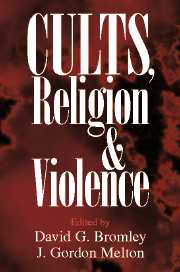Book contents
- Frontmatter
- Contents
- Acknowledgments
- Contributors
- Prologue
- 1 Violence and Religion in Perspective
- 2 Dramatic Denouements
- 3 Challenging Misconceptions about the New Religions–Violence Connection
- 4 Sources of Volatility in Religious Movements
- 5 Crises of Charismatic Legitimacy and Violent Behavior in New Religious Movements
- 6 Public Agency Involvement in Government–Religious Movement Confrontations
- 7 Watching for Violence: A Comparative Analysis of the Roles of Five Types of Cult-Watching Groups
- 8 Mass Suicide and the Branch Davidians
- 9 Occult Masters and the Temple of Doom: The Fiery End of the Solar Temple
- 10 Dramatic Confrontations: Aum Shinrikyô against the World
- 11 Making Sense of the Heaven's Gate Suicides
- 12 Lessons from the Past, Perspective for the Future
- Index
- References
6 - Public Agency Involvement in Government–Religious Movement Confrontations
Published online by Cambridge University Press: 09 July 2009
- Frontmatter
- Contents
- Acknowledgments
- Contributors
- Prologue
- 1 Violence and Religion in Perspective
- 2 Dramatic Denouements
- 3 Challenging Misconceptions about the New Religions–Violence Connection
- 4 Sources of Volatility in Religious Movements
- 5 Crises of Charismatic Legitimacy and Violent Behavior in New Religious Movements
- 6 Public Agency Involvement in Government–Religious Movement Confrontations
- 7 Watching for Violence: A Comparative Analysis of the Roles of Five Types of Cult-Watching Groups
- 8 Mass Suicide and the Branch Davidians
- 9 Occult Masters and the Temple of Doom: The Fiery End of the Solar Temple
- 10 Dramatic Confrontations: Aum Shinrikyô against the World
- 11 Making Sense of the Heaven's Gate Suicides
- 12 Lessons from the Past, Perspective for the Future
- Index
- References
Summary
The problem of collective religious violence is poorly understood, in part, because it is relatively rare. In the decade before the dawn of the new millennium, a cluster of incidents involving apocalyptic new religious movements captured the attention of scholars, government authorities, and the public. Four prominent cases of collective religious violence in the 1990s can be singled out: the Branch Davidian standoff near Waco in 1993; the Solar Temple mass suicides in Switzerland and Canada in 1994, 1995, and 1997; the Aum Shinrikyô sarin gas attacks and homicides in Japan in 1995; and the Heaven's Gate mass suicides in California in 1997. The question of pinpointing a common set of variables to explain violence among the few cases on record remains a formidable challenge to researchers. Clearly, the greatest obstacle to developing such a theory or model is that the circumstances and conditions are varied, making comparisons and generalizations difficult. The point can be illustrated through a brief overview.
Four Cases of Religious Violence
The Branch Davidian incident began as a government raid that triggered a shootout between the agents of the Bureau of Alcohol, Tobacco, and Firearms (BATF) and sect members on February 28, 1993. Four federal agents and six Branch Davidians died in the gunfire. The failed raid led to a fifty-one-day standoff in which the Federal Bureau of Investigation's (FBI's) Hostage Rescue Team conducted negotiations and applied tactical pressures to force the Davidians to surrender.
- Type
- Chapter
- Information
- Cults, Religion, and Violence , pp. 102 - 122Publisher: Cambridge University PressPrint publication year: 2002
References
- 5
- Cited by

